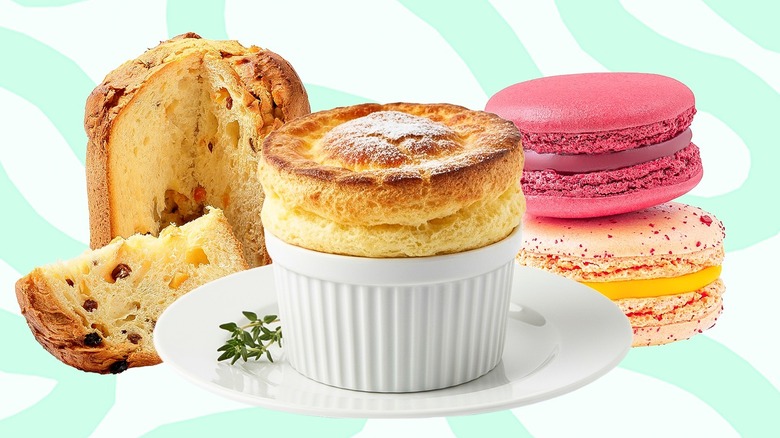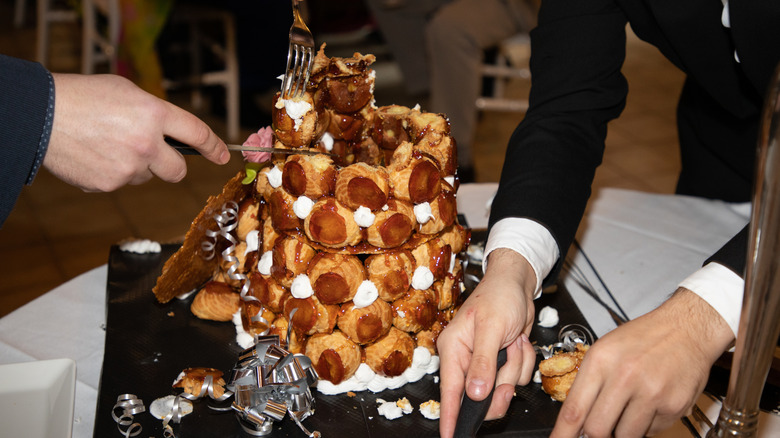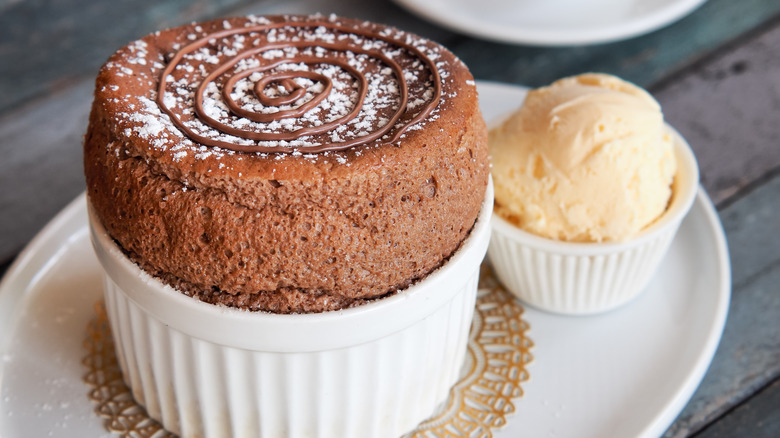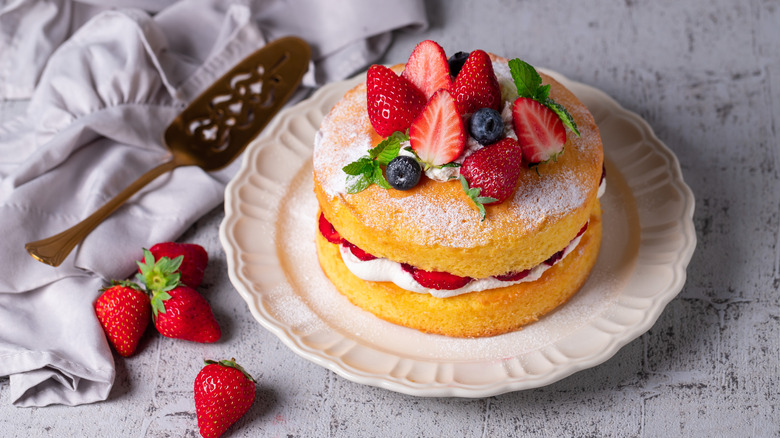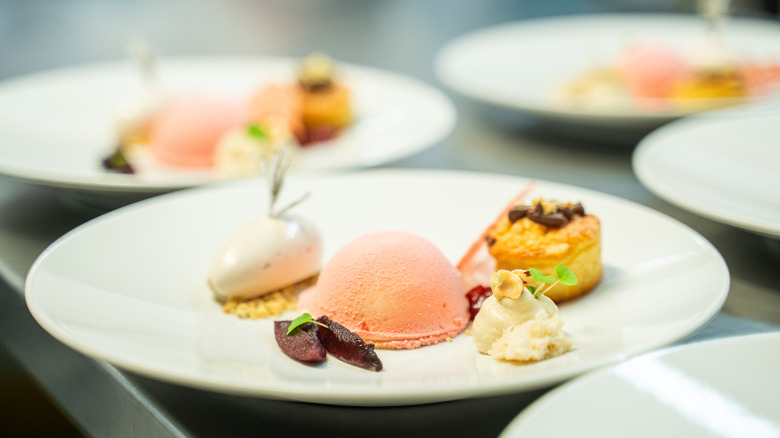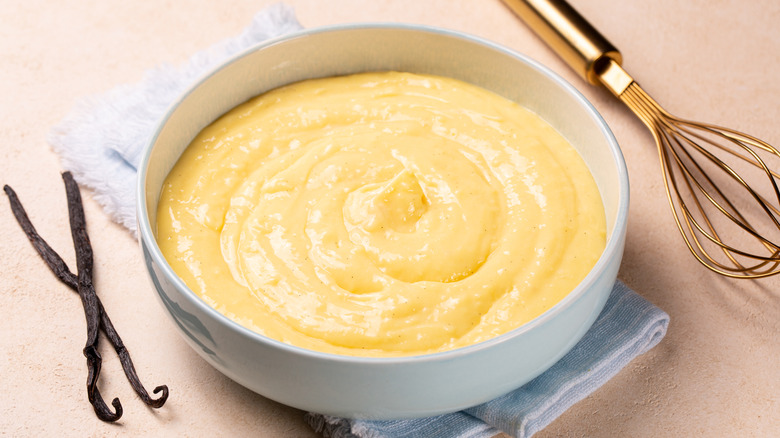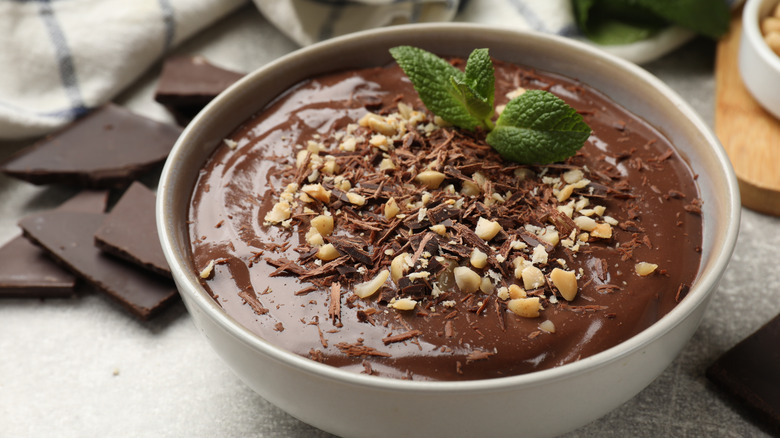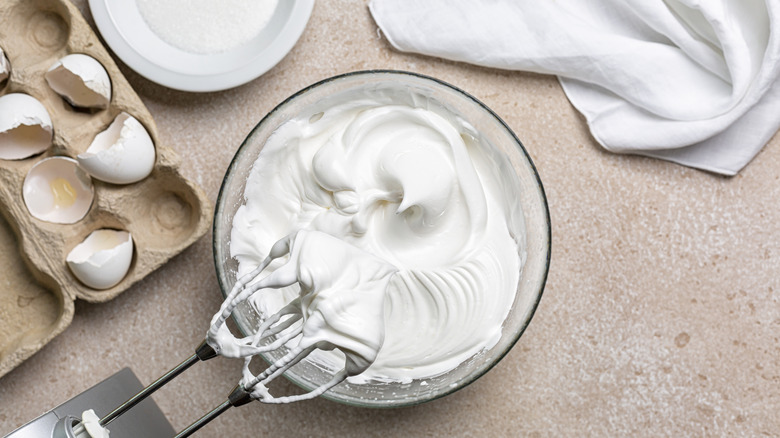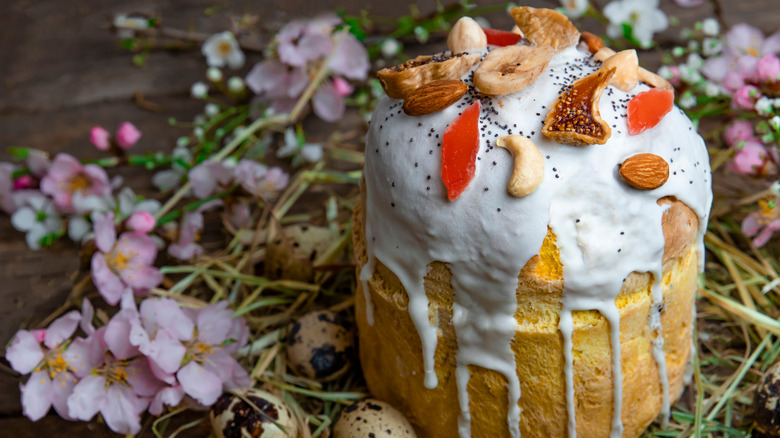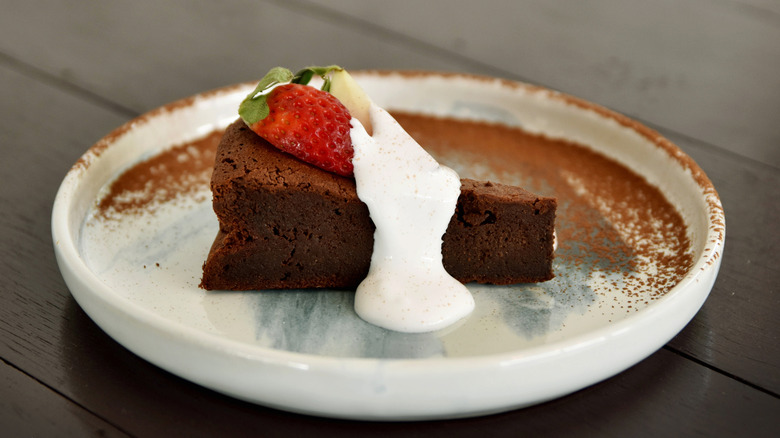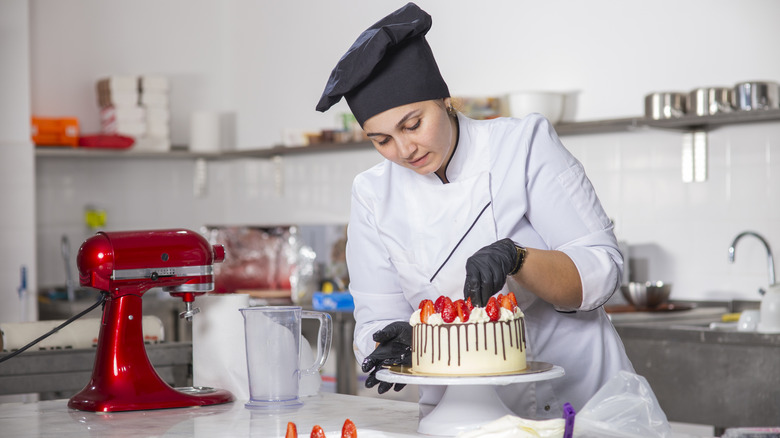Complicated Desserts That Aren't Worth Making At Home, According To Chefs
Behind every flawless looking and delicious tasting dessert is a chef who knows just what went down before it reached your table. From oven malfunctions to ingredient shortage, technical issues to weather conditions (yes, really!), there are innumerable little factors that contribute to a dessert's success. All that makes you wonder — is it even worth the effort trying to recreate these showstoppers at home? We asked three pastry chefs to share their thoughts on which desserts simply aren't worth your time and how to focus on the ones that are.
Chef Kara Blitz leads the pastry program at Lincoln Ristorante in New York and oversees desserts for the Metropolitan Opera. A graduate of the French Culinary Institute, she's known for transforming simple, traditional pastries into refined, modern creations that always put flavor first. From New Jersey, chef Becky Geisel of BEX Kitchen takes a different route — one that blends her background in design with her belief in fresh, honest cooking. A self-taught chef, she has spent over three decades building a food philosophy rooted in simplicity, creativity, and respect for good ingredients. Finally, chef Antonello Ghessa of Zeppola Café and Zeppola Bakery, brings authentic Italian sensibility to the pastry scene in New York and Las Vegas. Together, their insights offer a realistic and refreshing take on what makes some desserts worth the trouble and others better left to the professionals.
Layered trifles or croquembouches
After quizzing our experts, the conclusion is that some desserts do largely belong in restaurant kitchens. And they are calling them "not worth your while" for a reason. Chef Becky Geisel points to layered trifles or croquembouches as the best examples of such categories of desserts. She understands that they look stunning when completed, but that is also the result of perfect timing and precision. It has taken pastry chefs years of training and practice to accomplish this outcome. And even then, they can mess up. According to chef Geisel, all it takes is "one small mistake and it collapses." And you are left with a soggy mess, sometimes even before it reaches the table. According to our experts, these recipes depend on the kind of consistency and control that professional kitchens are built for.
Trifles, for example, require a fine balance between texture, moisture, and temperature. Even the best home equipment usually can't guarantee that sort of precision. A dazzling tower of croquembouches, also involves a literal race against gravity and humidity. There's caramel that needs to harden to the perfect consistency, cream that has to stay cool even when displayed at room temperature for a significant amount of time, and hands that work on everything with speed and confidence. If you are set on the idea of creating a showstopper, opt instead for a single-layer dessert or a safer version of the recipe. The difference is, you'll enjoy the process instead of holding your breath until it's done.
Soufflés and macarons
Some dessert recipes trick you into believing that the results are a sure shot. Maybe their ingredient list is deceptively short, or the method seems pretty straightforward. Whatever the reason, you decide to go ahead and try your luck. Soufflés and macarons are two of the biggest traps. Chef Becky Geisel calls them "unforgiving," and she's right. Both, according to her, depend on exact timing, temperature, and technique. Here's where a few minutes more in the oven could mean the difference between a fluffy light pudding and an extra whisking can turn into a cracked macaron shell.
Soufflés sound romantic — the kind of dessert that is quiet but dramatic as it rises. But that fluffy soufflé finish is the most fragile part. Professional kitchens and chefs handle soufflés with an extra quiet focus. Then there's panna cotta, which chef Antonello Ghessa says "everyone can make, but there's a delicate balance ... a lot of variables affect the outcome." It's just cream, sugar, and gelatin, but that gelatin determines the fate of the dessert. Too much and the dessert can end up a rubbery, inedible creation. Too little and it barely holds and is more cream than pudding. And for chef Kara Blitz, tempering chocolate at home is a minefield that she prefers to avoid. She explains, "It seems overwhelming to me because it can be a messy endeavor if the cook isn't fastidious about keep the workspace clean."
Sponge cake and ice cream
When asked about why certain desserts don't work at home, the answers from our experts were simple. For chef Becky Geisel, "Timing, tools, and ingredients all play a role. Many desserts need precise temperatures, specialized tools. Even minor deviations can affect texture." When it comes to desserts, when the temperature is off by a few degrees, or butter is beaten past the right point, or even sugar is cooked further than it should be, it can change the texture, rise, and flavor of any recipe.
"The beauty of baking is that ingredients are a lot more accessible than some fine dining food. Whereas the tools required for it are less available," says chef Antonello Ghessa. Professional pastry kitchens rely on ovens with stabilized heat controls, mixers and blenders that handle large quantities of ingredients, and pans that distribute heat evenly. When you are dealing with a home kitchen — an uncontrolled environment — even simple ingredients such as cream, butter, and chocolate don't behave predictably. Add in humidity, an oven that heats unevenly, a fridge that doesn't cool well (or is opened and closed continuously), and what should look perfect starts to slump or crack. In chef Kara Blitz's experience, "It's really been about getting to know the equipment. Is the oven temperature calibrated and are there hot spots? Does the freezer take overnight to fully freeze home-churned ice cream? But truly part of the fun of cooking at home ... is the creative problem solving we get to do."
Plated desserts
Some desserts simply aren't meant for a home kitchen. For chef Becky Geisel, it's those gorgeously plated, meticulously arranged desserts that come immediately to mind. "Multi-component plated desserts often rely on professional equipment and staff timing that's hard to replicate at home," says Geisel. Each element, from the base to the garnish, is prepared in advance and held at just the right temperature until it's time to plate. At home, it's almost impossible to have this kind of setup. In reality, what happens is that you are juggling the oven, the mixer, prepping ingredients, and dealing with a sink full of dishes, all at the same time.
Many plated desserts combine hot and cold elements. Think warm sponge with frozen mousse topped with a delicate tuile or airy foam. All these elements depend on quick assembly and well-choreographed coordination. In a restaurant, there's a rhythm to it: one person plates, another torches, another finishes. At home, most of the time, it's just you, and one person can only do so much. Chef Kara Blitz also advises against attempting confectionary items like torrone or norgat and candy at home. She warns, "The cooking temperatures of these items could easily lead to a trip to the hospital." Chef Antonello Ghessa reiterates the fears surrounding mastering soufflés. According to him, "Soufflés are generally harder to achieve in home kitchens than at restaurants. Items are already mised out and the oven is set to temp ... rarely do regular kitchen households have convection ovens."
Custards
Every baker has a story of a dessert that looked easy but turned into a small disaster. For many, macarons (not the same as macaroons) top that list. As chef Becky Geisel explains, "People underestimate the precision and patience required." Even experienced bakers struggle with cracked tops, hollow centers, or batter that spreads too much. Soufflés and custards sit in the same fidgety category. When it comes to technique, both rely on gentle heat and consistency. You risk the custard curdling beyond rescue if you cook it too much or too little, or the soufflé could deflate with a minor change in oven temperature. The margin for error in these types of desserts is razor-thin, and kitchen and baking equipment at home rarely guarantee the precision that pastry chefs take for granted.
Desserts like macarons and custards also test a cook's patience. There are never any guarantees, even if you can follow every step, measure everything exactly, and still end up with a less-than-perfect result. That's why even professionals sometimes skip them when baking at home. For chef Antonello Ghessa, "They look delicate and simple, but getting that perfect shell with just the right texture is a challenge at home and not a beginner-friendly dessert. I love the challenge in the kitchen, but for everyday baking, I'd rather make a batch of cookies, apple crumble, or a rustic cake — something forgiving and full of flavor, without all the precise fuss."
Cheesecakes and sponges
We asked our experts if having professional equipment really matters. Their replies were enlightening. For chef Antonello Ghessa, "Really depends on what you're cooking. But the short answer is yes. As a bakery, we purchase things in bulk, and it may not be easy to do so at home." At home, everything is scaled down, and that changes the outcome. Specialized equipment like a Rational oven, which can combine steam and convection heat, produces textures that are almost impossible to match in a regular home oven. With such specialized equipment, you can manage the moisture as well as the internal temperature, assuring you overall control over the two things that can make or break delicate bakes like cheesecakes, sponges, or custards. Working in her tiny hallway kitchen, chef Kara Blitz avoids any dessert requiring a freezer thanks to her "very small, full freezer in my NYC apartment."
While good tools can make a difference, they don't necessarily guarantee success. Most chefs agree that technique matters more than fancy, expensive equipment. You can make excellent desserts at home with standard equipment if you pay attention to method, timing, and temperature. As chef Becky Geisel explains, "They help, but technique matters most." It is important to learn your oven's quirks and techniques to bake better, find out which pans work best for the dessert you are making, and adjust recipes according to your budget and experience. What you lose in precision, you can make up for in practice and intuition.
Chocolate mousse and ganache
In baking, ingredients do more than build flavor; they mean the difference between how a dessert tastes, feels, and even looks. The fresher the eggs, the richer the butter and milk, and the better the quality of chocolate and fruit, and you are more than halfway on your way to a successful dessert. For recipes like mousse, custard, or ganache, even small variations in quality can affect the final texture. Lower-fat butter, older eggs, or chocolate with the wrong cocoa content can throw off the balance in ways you might not expect, but you will soon discover, if you insist on using them.
Chocolate is one of the clearest examples. "The art of chocolate is profound and delicate," says chef Antonello Ghessa. "We take it for granted how some chocolates have been made and presented." It's essential to understand that not all chocolate behaves the same way. Chef Kara Blitz concurs, "And it's true that difference between the ingredients chefs have access to and what we find in the grocery store are different. Getting familiar with fat content recommendations of dairy products could make the difference between a silky smooth mousse and a chocolate scrambled eggs." This doesn't mean you always need to spend a fortune on ingredients, however. What is important is to be mindful of their quality and freshness, especially when a dessert has only a few components.
Italian meringue
Not every delicious dessert needs a full day spent in the kitchen or a professional pastry diploma. Some of the most impressive sweet treats are the simplest to make. Don't believe us? Our experts are here to convince you otherwise. For chef Becky Geisel, her easy wins are "flourless chocolate cake, pavlova, or a seasonal fruit crisp. Elegant and forgiving, and the flavor always shines." They focus on flavor and texture and don't get bogged down with the need for perfection.
A pavlova may look intimidating, but with only egg whites, sugar, and patience, you can create a dessert that is as beautiful to look at as it is to eat. The beauty of a pavlova lies in the fact that it requires no precision tools or techniques to achieve its rough rustic edges and soft gooey center. The same goes for a flourless chocolate cake. Naturally gluten-free, this cake is rich and intense, promising luxury and indulgence with a few simple ingredients. If you want to take it up a notch, chef Antonello Ghessa urges you to try your hand at an Italian meringue: "Little more complicated than a typical meringue because it combines a heat component, but what you get is a nice velvety sheen that makes any dessert look more refined." It's a small skill to master and one that adds a professional finish. It's the perfect secret trick for professional-looking pie topping or to swirl over cakes.
Panettone
With our experts being confident professionals and pros in the kitchen, what are their personal blind spots when it comes to mastering a difficult dessert? Chef Becky Geisel points to Italian meringue-based classics like tiramisu and zabaglione. "They look simple," she says, "but balancing texture and flavor takes real attention. The whipped eggs and sugar need to reach the right temperature for structure without losing their lightness. Too much heat and you end up with scrambled eggs; too little and the dessert won't hold."
Then there's panettone, a challenge that humbles many professionals. Chef Antonello Ghessa explains that "the process is very different from typical bread." Panettone requires a fair amount of space in which it has to be hung upside down after being removed from the oven. Made with a rich, slow-rising dough that usually takes several days to ferment and develop its iconic intense flavor, the loaves hang upside down to keep their tall, domed shape. Chef Ghessa warns against skipping this step and risking the entire confection collapsing and losing its shape. Desserts like these test not only our chefs' patience but also the limitations of their workspaces. Chef Kara Blitz sums up the difference between a professional and home kitchen: "I feel like anything can get out of hand quickly. The key for me is making sure to clean as I go. At work we have a dedicated person washing dishes; it makes a world of difference."
Worth the effort: chocolate mousse, fruit tart, or flourless chocolate cake
If you ever wonder why you started (and fell in love) with baking, the answer is that some desserts really are worth the time and effort they take. They not only look impressive but taste incredible. Chef Becky Geisel's picks are chocolate mousse and fruit tarts. "Both look impressive, taste incredible, and are achievable with patience and proper prep," she says. With just a few simple ingredients like melted chocolate (good quality, mind), beaten egg whites and whipped cream, you end up with a luscious, rich yet not overpowering dessert.
Chef Antonello Ghessa's go-to is a chocolate almond flourless cake. "It's delicious, has the texture of a regular cake, but it's gluten free and everyone loves it," she says. It's rich, balanced, and adaptable. You can dress it up with ganache or keep it plain with a dusting of sugar and some fresh berries on the side. These are desserts that are approachable, satisfying, and forgiving and the kind of recipes that remind you baking is meant to be enjoyable and not stressful. For chef Kara Blitz, it's the little tweaks that make all the difference: "I think anything can be gussied up with ... some whipped cream and fresh berries, or other seasonal fruit. Throwing in a little 'twist,' ... different shape, unexpected ingredient ... to make the dessert stand out from the pack a bit can enhance any guest experience, especially at home."
A chef's final advice
The unanimous response from our experts when it comes to tackling a difficult recipe or overcoming your baking fears is simple — just keep going. Mistakes are always part of the process and should not be feared. Chef Becky Geisel's advice is simple: focus on flavor over perfection. "Ingredients, balance, and timing are key," she says, "and don't get lost chasing exact shapes or height." A cake that looks wonky or one that is not expertly frosted will still win over hearts if it tastes good. In comparison, a technically perfect dessert will fall flat if people are averse to the taste.
Chef Antonello Ghessa agrees. "Don't give up," he says. "Even professional bakers get it wrong. It's about getting to know your tools and your ingredients." His example comes from bread-making, where the mother yeast has its own personality. No two are the same, and each reacts differently depending on temperature, humidity, and feeding habits. "The more time you spend with it, the better you understand its characteristics," he explains. That principle applies to everything in baking: the more you work with your tools and ingredients, the more intuitive it becomes. As chef Kara Blitz sums up, "If there is a will there's a way. I have certainly been humbled by my home kitchen. But we try, try again. Finding an easier, smarter, safer way to work with my home kitchen has actually been very satisfying."
